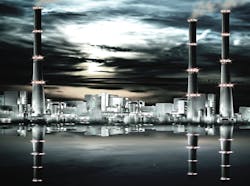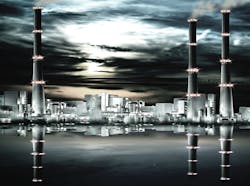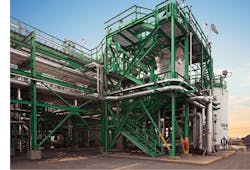Global water scarcity and evolving trends in data analytics and efficiency will shape industrial water reuse in the years ahead
By Jeff Gunderson
A 2017 UN World Water Development report, “Wastewater: The Untapped Resource,” found that in the face of ever-growing demand, the paradigm of wastewater management is shifting from ‘treatment and disposal’ to ‘reuse, recycle and resource recovery.’ This trend is especially evident in industry, according to the report, where wastewater is increasingly being viewed as a potential resource and its use or recycling after suitable treatment as a potential way to generate economic benefits — which in turn complements corporate social responsibility, water stewardship and sustainable development.
Experts see similar trends driving the global market for industrial water recycling and reuse in 2018 but also forecast other emerging drivers that are beginning to transform the way in which projects are designed, implemented, and operated.
“Water reuse is a growth market, with more and more industrial operators pursuing reuse opportunities based on regionally-dependent drivers that include water scarcity, environmental regulations, and rising raw water costs,” said Karl Millauer, CEO of the Aquarion Group. “More companies are also adopting water reuse practices to minimize their water footprint as part of a larger corporate water efficiency or sustainability program.”
In response to severe water stress, industrial water recovery projects are being planned and implemented in areas such as Southern Italy, India, South Africa, and in Northern China where zero-liquid discharge is mandated due to tremendous water shortage, according to Millauer. But in other countries where supplies are plentiful and water costs low — such as Switzerland, Austria, and Russia — Millauer said investments in water reuse are nearly non-existent in the absence of a driver.
Where freshwater supplies are limited, Millauer said desalination can sometimes present a more affordable and lower risk alternative compared to reuse, especially when wastewater streams are highly contaminated or variable. “As such, the industry is working to create more standardized reuse solutions as a cost-reduction strategy to make systems more financially competitive,” Millauer said.
Devesh Sharma, managing director at Aquatech International, said some of the most water scarce regions of the world are also some of the fastest growing, and in these areas water stress is intensifying in step with population increase, urbanization, and industrial growth, creating unprecedented future demand among competing uses. “Water scarcity drives environmental regulations, and combined, these factors create corporate water risk — which ultimately is the main reason that will compel owners and operators to invest in water recycling and reuse,” according to Sharma.
At the Co-op Refinery Complex (CRC) in Regina, Saskatchewan (Canada), SUEZ’s ZeeWeed MBR technology helps the refinery treat and recycle 100 percent of its wastewater for steam production. Photo: SUEZ Water Technology & Solutions.
Greater Emphasis on Fit-for-Purpose and Closed-Loop Approaches
As water demand escalates and the need to secure water supply becomes more critical, experts see industrial water recycling and reuse increasingly defined by more purposeful and better designed projects to both maximize investments and enhance benefits.
An example includes tailoring effluent qualities to specific end uses. “Water recycling and reuse engineered with a fit-for-purpose approach can result in a much more cost-effective project,” said Steve Katz, market development manager with Suez Water Technologies and Solutions. “Customizing local clusters of treatment with distinct reuse objectives in mind is an approach that we will see a lot more of in the future. We see this model already used extensively in the agriculture industry, where advanced purification isn’t needed to produce water for irrigation. Instead, treatment targets pathogens but not nutrients.”
Extending this model to industrial facilities and adjusting treatment trains accordingly to targeted endpoints can create the most water-efficient and low-energy design, Katz said. “The level of quality required for a cooling tower is different compared to a boiler or the various process washes,” he said. “By planning for this, facilities can avoid unnecessary costs associated with over treatment.”
Industrial operators — especially those in water-stressed locales — are also becoming more interested in adopting closed-loop water recycling systems for mitigating corporate water risks and enhancing future water security, according to Sharma.
“In line with this interest, we are collaborating more with industries in implementing holistic water management approaches,” Sharma said. “An example could include looking at all points in a facility where wastewater is generated, and, after exploring ways to cut usage and decrease those volumes, we then consider every opportunity to reuse 100 percent of wastewater. Implementing this kind of strategy, where end-of-pipe discharge is eliminated, can certainly result in cost savings, but sometimes these measures have to be viewed as more strategic in the context of water-related risks that could potentially shut an operation down.”
The CRC Refinery in Regina, Saskatchewan. Photo: SUEZ Water Technology & Solutions.
The Emerging Impact of Analytics
The rapid emergence of data analytics and advanced monitoring technologies is one of the most significant trends that is quickly transforming the water sector and beginning to introduce dramatic changes in the way treatment systems and recycling and reuse projects are operated.
“The digital transformation of this industry is going to be one of the biggest shifts we see moving forward,” Katz said. “New tools becoming available will allow us to better monitor processes and to react, learn, and operate systems much more efficiently. We’re talking machine learning, real-time modeling, and very robust data collection and analytics.”
By providing insights for reducing power consumption, lowering chemical use, and implementing proactive and more targeted maintenance, data-driven analytics will enable operators to optimize water reuse equipment, contributing to a lower cost of ownership, according to Katz.
Advanced analytics are expected to be increasingly relevant in terms of monitoring produced water qualities and tracking constituent concentrations as part of a more tightly controlled water reuse process, according to Sharma. “The variability of wastewater is one of the most critical issues with water reuse,” he said. “This is where advancements in instantaneous sensing technologies and diagnostics can be vital for enabling operators to respond to critical fluctuations.”
The CRC Refinery in Regina, Saskatchewan. Photo: SUEZ Water Technology & Solutions.
Calculating the Return on Water Reuse Investments
To better understand the payback of industrial water reuse investments, the Water Environment & Reuse Foundation (WE&RF) is developing a new tool that will help owners and operators to more accurately determine the return-on-investment (ROI) of projects. Funded by the California State Water Resources Control Board and the Bureau of Reclamation, the ROI tool will take into account a range of cost factors including but not limited to raw water sourcing and disposal, treatment, heating and cooling, and conveyance.
“One of the biggest hurdles to industrial water reuse adoption is making a business case for the investment,” said WE&RF Research Manager Justin Mattingly. “What we are trying to do with this tool is peel back the onion to reveal the true costs and full extent of economic benefits.”
WE&RF’s new tool, which will be available later this year, will consider how an optimized layout of water reuse equipment and infrastructure can decrease ancillary costs, such as those related to pumping. “Many industrial campuses are quite large, which contributes to the cost to move reclaimed water around a facility,” Mattingly said. “But if certain waste stream qualities can be matched to the input of other processes, owners could potentially save money compared to pumping treated wastewater from a single location.”
Further costs that are factored include those related to acquiring permits as well as what WE&RF refers to as the ‘shadow cost’ of water. “It’s not an expense that would appear on an accounting ledger, but what it takes into account is the risk associated with water stress and supply limitations,” Mattingly said. “Even in areas where water is cheap, a drastic reduction in supply can bring devastating impacts. The shadow cost establishes a monetary value on that risk.” IWW
About the Author: Jeff Gunderson is a correspondent for Industrial WaterWorld. He is the founder of Waterstone Writing (waterstonewriting.com), a specialized content provider with a core focus in water, technology, energy and sustainable solutions. Gunderson is also a part-time faculty instructor at Portland State University, teaching in the Professional and Technical Writing program. He holds a master’s degree in Environmental Science and Engineering from the Colorado School of Mines and a bachelor’s degree in General Science from the University of Oregon.






